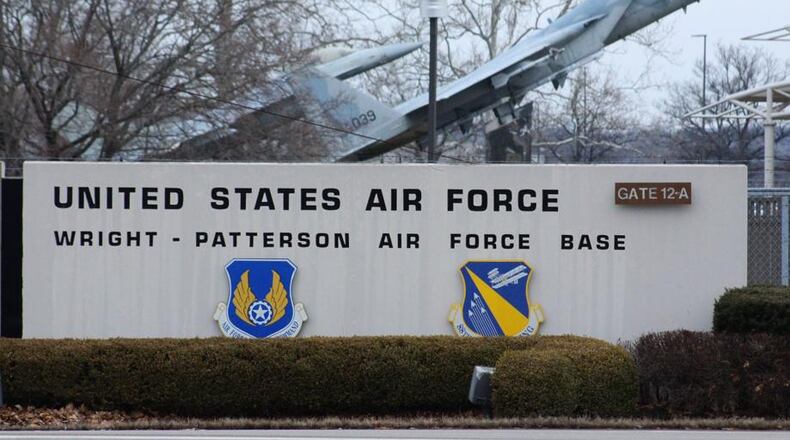“Wright-Patterson Air Force Base and the Dayton region would be excellent hosts for the U.S. Space Command's new headquarters,” said DeWine. “This area is already home to the National Air and Space Intelligence Center, Air Force Research Laboratory, Air Force Life Cycle Management Center and Air Force Material Command. It's a powerful combination and a synergy that you can't find anywhere else.”
If selected, the headquarters could bring up to 1,400 personnel to the state.
>> RELATED: Space City? Challenge — and opportunity — lie in Space Command competition
The governor sent a letter to the assistant secretary of the Air Force today endorsing the nomination submitted by Beavercreek Mayor Bob Stone. Another letter signed by 22 area mayors and four county commission presidents that supported the Dayton region’s consideration for the headquarters was also submitted.
In May, the Department of the Air Force announced that it was accepting nominations for the headquarters’ location.
>> RELATED: New Space Force will depend on Wright-Patt missions
WPAFB and the Dayton region meet all the screening requirements, according to the governor.
State Sen. Bob Hackett, R-London, has also introduced a proposed resolution urging that Ohio be chosen as command headquarters.
U.S. Space Command was created by President Donald Trump in 2018. While U.S. Space Force headquarters has been – and will remain – in the Pentagon, U.S. Space Command has been temporarily located in Colorado Springs, Colorado.
Competing for the command and its 1,400 good jobs will be a distinct challenge for Dayton, said John Boyd, owner of Princeton, N.J.-based Boyd Co., a national location consulting firm.
“Dayton clearly is an outlier in the competition for the new Space Command headquarters,” Boyd said Monday.
Even as it faces an uphill climb, there are strengths the Dayton area enjoys that advocates can emphasize — assets that can boost the region in other ways, drawing positive attention from a global corporate audience, Boyd said.
For example, the Dayton area boasts impressive intellectual capital, and Dayton leaders should talk more about that, he suggested.
“Only four markets in the nation have more science and engineering graduates in the labor market,” Boyd said. “How many executives know that right now? Not enough.”
Dayton hasn’t had a signature corporate presence since NCR pulled its headquarters from the region to the Atlanta area in 2008 and 2009.
But the presence of Wright-Patterson Air Force Base, a major Air Force center of research and logistics efforts, can continue to benefit the region, Boyd and Thompson said.
“The existing aerospace cluster, and its official designation as the state’s aerospace hub, that is worthy of a national promotion effort,” Boyd said.
While Dayton is competing against cities that enjoy higher levels of “in-migration,” the Miami Valley can boast of a lower cost of living, lower construction costs and fewer traffic hassles.
Further, in the post-COVID-19 landscape, Boyd expects companies to be more open to locating in smaller cities, away from crowded urban areas.
Among the criteria laid out by the Pentagon in its search for a Space Command headquarters: Communities that are within 25 miles of a military base, within the top 150 most populous “metropolitan statistical areas,” and score at least 50 out of 100 points on the American Association of Retired Persons’ Livability Index, among other criteria.
Dayton clearly has a military base nearby. As of July 2019, the Dayton-Kettering MSA was ranked at 107. And according to the AARP Index, the Dayton area scores a 53.
Boyd expects California and Florida — with the latter state’s “Space Coast” — to emerge as strong contenders for the headquarters.
Advocates for Dayton expect to stress Wright-Patterson and the Springfield Air National Guard Base, as well as the rapidly growing National Air and Space Intelligence Center (NASIC) and the 178th Intelligence, Surveillance and Reconnaissance Group, and Air Force Research Laboratory, all in the area.
Elaine Bryant, executive vice president for aerospace and defense for the Dayton Development Coalition, said Dayton may be an “underdog” compared to other markets. But that won’t deter the community from making its case, she said.
The next step is laying out the area’s proposal, illustrating how the region “meets and exceeds” the Pentagon’s criteria, she said.
“We have everything that it takes,” Bryant said.
“When you look at all the criteria, Dayton, Ohio scores extremely high in all of those areas,” said Jeff Hoagland, president and chief executive of the coalition.
“We’re not going to shy away from this,” he added.

